
How to Beat Stronger Chess Players: Part 1
Hi everyone! I’m Max Gedajlovic, an International Master from Canada, and I’m planning on starting a regular blog here on lichess. In the blog, I’ll do deep dives into chess improvement topics, and make extensive reference to the lessons I’ve learned in my own competitive career.Part 2: https://lichess.org/@/mmsanchezchess/blog/how-to-beat-stronger-players-part-2/DZxwft1Y
Part 3: https://lichess.org/@/mmsanchezchess/blog/how-to-beat-stronger-players-part-3/JWAixlb2
To start, I’ll provide a little bit of context about myself and why I chose this topic for my first post here. I started playing chess in grade 4, and pretty quickly improved to around 1800-1900 CFC without encountering too many serious hurdles. However, it was at that point that in order to continue progressing I needed to start beating people above the mythical 2000 rating. Chess wise I was there, but psychologically I was not. I’d win crushing games against people with my rating, only to play much worse and blow chances to win as soon as I faced 2000+ opposition.
Eventually I got past that plateau. However it was more because my overall chess level improved to the point where I could win in spite of my nerves, and not because of a psychological breakthrough that would make chess improvement systemically easier from there on out.
In 2015, I earned the FM title at the age of 14. This was a major milestone for me, but again it left me at a tricky plateau to overcome. If I wanted to keep rising up the ranks, I’d need to start earning IM norms, and the only realistic way to do that was to start taking wins off IM level opposition. My rating bounced between 2300 and 2350 for the next couple years, but no serious progress was made. I’d usually not have huge issues beating up lower rated opponents, but would still struggle against higher rated players. Sometimes I’d hold draws, but usually I’d be on the defending side and would almost never win. In 2017, after a particularly poor stretch of tournaments that saw my rating dip below 2300 for the first time since I earned FM, I decided to step away from the game.
In 2021, restless from the pandemic, and having not played a FIDE rated game in almost 4 years, I decided to return to chess for a few tournaments. I had done relatively little preparation and had modest expectations, just wanting to play again and hopefully not embarrass myself too much. However, to my surprise I had immediate success again, defeating a Grandmaster in my first tournament back, and raising my rating back from 2270 to around my all time peak of 2345 in 3 tournaments. My form was obviously less sharp than I was back in 2015. I’d miscalculate or forget my opening theory far more often, However, I realized that a lot of the nerves and intimidation I used to have when playing strong opponents had gone away, and I was able to play more confident games against them. Motivated by my newfound success, I worked hard and played several norm events over the next year and a half, eventually earning the IM title, and scoring many wins against GMs and strong IMs along the way.
The lesson I took away from this, is that in order to score against higher rated opponents, you need to play against them in basically the same way you’d play against an opponent of your level or lower, and have the same confidence in your ability to win. In the rest of this series of posts, I’ll go into the most common ways that I and many other chess players have played differently and worse against higher rated opponents, and how to recognize and avoid it.
- Playing too passively
This is the most obvious, and in my experience the most common way people negatively modify their play style when facing a higher rated opponent. The idea seems sensible at first, play super solidly and give your opponent no openings, and you’ll hold on for a draw. However, in practice this strategy almost results in defeat. We aren’t Wesley So, and we can’t play flawless defense and hold a draw in a Berlin endgame in every game at will. For basically every player up to master strength, and most above it, attacking is more fun, more intuitive, less time consuming and overall easier than defending. Setting yourself up to be the defender is like taking the outside lane in a race, you are gonna be playing a more demanding game than your opponent, and 9 times out of 10 you’ll be the first one to crack.
https://lichess.org/study/lkqqLeWI/Yr4sh9cD#1
This game is obviously a damning fail case of that strategy, but I'd argue even when passive/solid play starts off ok and you get a decent position, it doesn't work very well in securing you a draw. I'll finish off by illistrating that with two positions.
https://lichess.org/study/5LZnpKVl/dJIUjfqo
https://lichess.org/study/5LZnpKVl/uezFQLsN
Highlighted are two positions where I faced higher rated opponents, and offerred draws. Which one do you think was accepted?
In the game against Howard Wu, I had played very solidly and forced several exchanges, resulting in a quite simplified position. I played 22...Re2, anticipating the eventual exchange of the f7 and e5 pawns, leading to a RR and two pawns vs RR and two pawns endgame that should be very equal. Draw in the bag then right? Well, not so fast. Of course the position is objectively drawn, but white's got two rooks on the seventh, a safer king and 400 rating points on me. What's in it for white to give a draw so soon? He can keep playing on forever, making slow progress, and hope I mess up eventually. And that's exactly what happened.
The game against Ivan Schitco was the last round of the Hollywood Masters, a tournament in which I had played quite well up till that point, but needed a draw to clinch my first IM Norm. In this position I played the aggressive move 34...c4, and offerred a draw. At first that seems counterintuive, why sacrifice material and play risky if all you need is a draw? Well, think about it from white's perspective. He's got no great choice but to take the pawn on with his queen, after which I get to bring my rook to the open c-file with a tempo, and follow it up with Ng6, heading into the juicy e5 and f4 squares. Yes white's got an extra pawn, but black's got a scary passer and very active pieces, its easy to see black's initiative overwhelming white's defenses and winning the game. White's risking big time by playing on, because I played actively and aggressively, and put the real fear of losing into his mind. After thinking for 5 or so minutes, white agreed to the draw, and I clinched the norm.
Hopefully the difference between these examples is clear. In the first one, the position is very simplified, and black seems quite safe on the surface. However, white still has a few trumps and runs 0 risk of losing, so he's got no reason to give up the draw. In contrast, the second position is much more dynamically inbalanced, with black about to go down a pawn for active counterplay. It's true there's more ways for this position to go wrong for black than the first one, but there are also way way way more ways for it to go wrong for white. Active, attacking play made white afraid of losing, which made him willing to give up a draw, whereas solidly going for exchanges and passive defense gave white nothing to fear, and lead to him playing on until I erred.
That's it for me today! But I'll be back soon with my next post about mistakes players make when facing higher rated opponents, and strategies you can use in order to have more success against them. Please let me know if you enjoyed this, and if you have any feeback about how I could make it more interesting for everyone!
More blog posts by mmsanchezchess

How to Play against Lower Rated Opponents Part 1: Know your Advantage
Previously, I have written a series on how to do well and score upsets against higher rated opponent…
Level Up Your Endgames Part 3: 2 Rook Endgame Ideas You Have to Know
In my first section I talked about how the strength of passed pawns depends significantly on what fi…
Level up your endgames Part 2: The Strengths and Weaknesses of the Minor Pieces
Hi Everyone! I’m back with the second part of my series on leveling up your endgame play. In my firs…